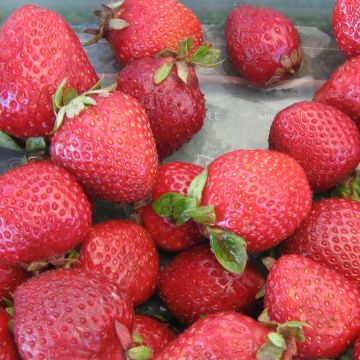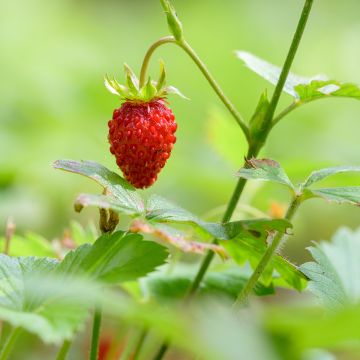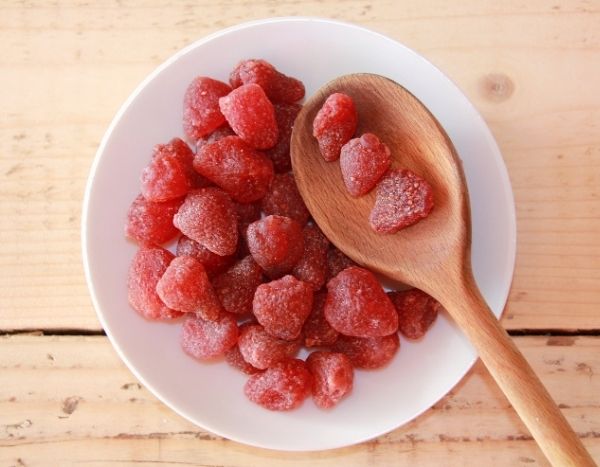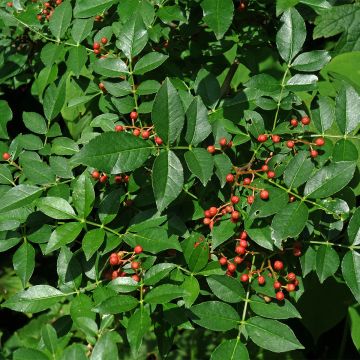

Wild Strawberry Yellow Wonder - Fragaria vesca
Wild Strawberry Yellow Wonder - Fragaria vesca
Fragaria alpina Yellow Wonder
Wild Strawberry, Alpine Strawberry
Yellow Alpine strawberry, I am the opposite and I hope it will produce when planted in a planter for now.
Nath44, 06/02/2024
Special offer!
Receive a €20 voucher for any order over €90 (excluding delivery costs, credit notes, and plastic-free options)!
1- Add your favorite plants to your cart.
2- Once you have reached €90, confirm your order (you can even choose the delivery date!).
3- As soon as your order is shipped, you will receive an email containing your voucher code, valid for 3 months (90 days).
Your voucher is unique and can only be used once, for any order with a minimum value of €20, excluding delivery costs.
Can be combined with other current offers, non-divisible and non-refundable.
Home or relay delivery (depending on size and destination)
Schedule delivery date,
and select date in basket
This plant carries a 12 months recovery warranty
More information
We guarantee the quality of our plants for a full growing cycle, and will replace at our expense any plant that fails to recover under normal climatic and planting conditions.

Would this plant suit my garden?
Set up your Plantfit profile →
Description
Fragaria alpinum 'Yellow Wonder', sometimes called yellow wood strawberry, is an alpine strawberry whose small white strawberries turn yellow when ripe. This colour is unappealing to birds. The sweet strawberries have a scent like woodland strawberries. The plant does not produce runners, but it forms a compact clump that blooms and produces fruit throughout the season. This hardy variety can be grown in the ground or in a pot, in partial shade. It likes humus-rich, well-drained soil that remains slightly moist.
The alpine strawberry belongs to the Rosaceae family, just like many fruit trees (apple, pear, plum, medlar) and many ornamental plants (roses, avens, physocarpus). It is found in alpine woodlands, where the leaf litter provides a suitable carpet for its establishment. Unlike many strawberries, this one does not spread on the ground through long stems called runners. The plant forms a small, dense and neat clump that stays in place. The dark green leaves are composed of three toothed leaflets. They are semi-evergreen if the climate is not too cold. Between May and September, the plants produce small white flowers with 5 petals and a yellow central cone. Under good conditions, these flowers transform a few weeks later into small white fruit that turn yellow when fully ripe. Its flesh is sweet, fragrant, and aromatic. From a botanical point of view, strawberries are pseudocarps. The seeds on the strawberry (achenes) are the true fruits, while the red fleshy envelope is just a means for the plant to facilitate their dispersal by animals.
Fragaria alpinum 'Yellow Wonder' is an extremely hardy plant (down to -18°C (-0.4°F)). It can thrive under bushes and trees. Its production will be better in humiferous, rich soil that is not too dry. Plant it in partial shade or under non-burning sun. It is ideal for semi-shaded rockeries and slightly wild beds, where it will enhance taller plants such as bleeding heart 'Valentine', and large ferns such as Lady Fern (Athyrium filix-femina). It can be grown in planters or hanging baskets on slightly shaded patios or balconies.
Wild Strawberry Yellow Wonder - Fragaria vesca in pictures


Flowering
Foliage
Plant habit
Botanical data
Fragaria
alpina
Yellow Wonder
Rosaceae
Wild Strawberry, Alpine Strawberry
Alps
Other Strawberry plants
View all →Planting and care
It prefers a spot in partial shade, without scorching sunlight. Plant your strawberry in a well-draining mix enriched with a leaf compost or potting soil. The soil should always remain slightly moist, without being waterlogged. It can self-seed spontaneously if fruits are left on the plant.
Planting period
Intended location
Care
Planting & care advice
-
, onOrder confirmed
Reply from on Promesse de fleurs
Similar products
Haven't found what you were looking for?
Hardiness is the lowest winter temperature a plant can endure without suffering serious damage or even dying. However, hardiness is affected by location (a sheltered area, such as a patio), protection (winter cover) and soil type (hardiness is improved by well-drained soil).

Photo Sharing Terms & Conditions
In order to encourage gardeners to interact and share their experiences, Promesse de fleurs offers various media enabling content to be uploaded onto its Site - in particular via the ‘Photo sharing’ module.
The User agrees to refrain from:
- Posting any content that is illegal, prejudicial, insulting, racist, inciteful to hatred, revisionist, contrary to public decency, that infringes on privacy or on the privacy rights of third parties, in particular the publicity rights of persons and goods, intellectual property rights, or the right to privacy.
- Submitting content on behalf of a third party;
- Impersonate the identity of a third party and/or publish any personal information about a third party;
In general, the User undertakes to refrain from any unethical behaviour.
All Content (in particular text, comments, files, images, photos, videos, creative works, etc.), which may be subject to property or intellectual property rights, image or other private rights, shall remain the property of the User, subject to the limited rights granted by the terms of the licence granted by Promesse de fleurs as stated below. Users are at liberty to publish or not to publish such Content on the Site, notably via the ‘Photo Sharing’ facility, and accept that this Content shall be made public and freely accessible, notably on the Internet.
Users further acknowledge, undertake to have ,and guarantee that they hold all necessary rights and permissions to publish such material on the Site, in particular with regard to the legislation in force pertaining to any privacy, property, intellectual property, image, or contractual rights, or rights of any other nature. By publishing such Content on the Site, Users acknowledge accepting full liability as publishers of the Content within the meaning of the law, and grant Promesse de fleurs, free of charge, an inclusive, worldwide licence for the said Content for the entire duration of its publication, including all reproduction, representation, up/downloading, displaying, performing, transmission, and storage rights.
Users also grant permission for their name to be linked to the Content and accept that this link may not always be made available.
By engaging in posting material, Users consent to their Content becoming automatically accessible on the Internet, in particular on other sites and/or blogs and/or web pages of the Promesse de fleurs site, including in particular social pages and the Promesse de fleurs catalogue.
Users may secure the removal of entrusted content free of charge by issuing a simple request via our contact form.
The flowering period indicated on our website applies to countries and regions located in USDA zone 8 (France, the United Kingdom, Ireland, the Netherlands, etc.)
It will vary according to where you live:
- In zones 9 to 10 (Italy, Spain, Greece, etc.), flowering will occur about 2 to 4 weeks earlier.
- In zones 6 to 7 (Germany, Poland, Slovenia, and lower mountainous regions), flowering will be delayed by 2 to 3 weeks.
- In zone 5 (Central Europe, Scandinavia), blooming will be delayed by 3 to 5 weeks.
In temperate climates, pruning of spring-flowering shrubs (forsythia, spireas, etc.) should be done just after flowering.
Pruning of summer-flowering shrubs (Indian Lilac, Perovskia, etc.) can be done in winter or spring.
In cold regions as well as with frost-sensitive plants, avoid pruning too early when severe frosts may still occur.
The planting period indicated on our website applies to countries and regions located in USDA zone 8 (France, United Kingdom, Ireland, Netherlands).
It will vary according to where you live:
- In Mediterranean zones (Marseille, Madrid, Milan, etc.), autumn and winter are the best planting periods.
- In continental zones (Strasbourg, Munich, Vienna, etc.), delay planting by 2 to 3 weeks in spring and bring it forward by 2 to 4 weeks in autumn.
- In mountainous regions (the Alps, Pyrenees, Carpathians, etc.), it is best to plant in late spring (May-June) or late summer (August-September).
The harvesting period indicated on our website applies to countries and regions in USDA zone 8 (France, England, Ireland, the Netherlands).
In colder areas (Scandinavia, Poland, Austria...) fruit and vegetable harvests are likely to be delayed by 3-4 weeks.
In warmer areas (Italy, Spain, Greece, etc.), harvesting will probably take place earlier, depending on weather conditions.
The sowing periods indicated on our website apply to countries and regions within USDA Zone 8 (France, UK, Ireland, Netherlands).
In colder areas (Scandinavia, Poland, Austria...), delay any outdoor sowing by 3-4 weeks, or sow under glass.
In warmer climes (Italy, Spain, Greece, etc.), bring outdoor sowing forward by a few weeks.

























































